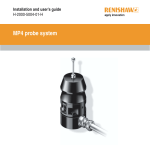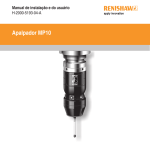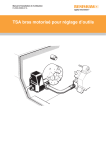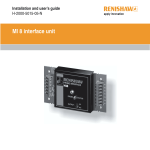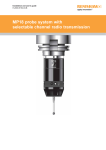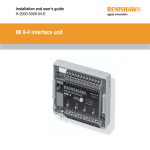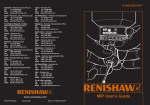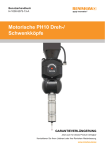Download Renishaw H-2000-5015-05-N User`s guide
Transcript
Renishaw plc New Mills, Wotton-under-Edge, Gloucestershire, GL12 8JR United Kingdom T +44 (0)1453 524524 F +44 (0)1453 524901 E [email protected] www.renishaw.com Installation and user’s guide H-2000-5002-02-A MP3 probe with inductive or hard-wired signal transmission system For worldwide contact details, please visit our main website at www.renishaw.com/contact © 2001 - 2003 Renishaw plc. All rights reserved. Disclaimer Renishaw® is a registered trademark of Renishaw plc. Considerable effort has been made to ensure that the contents of this document are free from inaccuracies and omissions. However, Renishaw makes no warranties with respect to the contents of this document and specifically disclaims any implied warranties. Renishaw reserves the right to make changes to this document and to the product described herein without obligation to notify any person of such changes. This document may not be copied or reproduced in whole or in part, or transferred to any other media or language, by any means, without the prior written permission of Renishaw. The publication of material within this document does not imply freedom from the patent rights of Renishaw plc. Trademarks All brand names and product names used in this document are trade names, service marks, trademarks, or registered trademarks of their respective owners. Renishaw part no: H-2000-5002-02-A Issued: 06 03 1 Installation and user's guide MP3 inspection probe with inductive or hard-wired transmission system 2 FCC DECLARATION (USA) GB - WARNINGS FCC Section 15.19 Information for the user This device complies with Part 15 of the FCC rules. Beware of unexpected movement. The user should remain outside of the full working envelope of probe head/extension/probe combinations. Operation is subject to the following two conditions: 1. This device may not cause harmfull interference. 2. This device must accept any interference received, including interference that may cause undesired operation. FCC Section 15.105 This equipment has been tested and found to comply with the limits for a Class A digital device, pursuant to Part 15 of the FCC rules. These limits are designed to provide reasonable protection against harmful interference when the equipment is operated in a commercial environment. This equipment generates, uses, and can radiate radio frequency energy and, if not installed and used in accordance with the instruction manual, may cause harmful interference to radio communications. Operation of this equipment in a residential area is likely to cause harmful interference, in which case you will be required to correct the interference at your own expense. FCC Section 15.21 The user is cautioned that any changes or modifications not expressly approved by Renishaw plc, or authorised representative could void the user's authority to operate the equipment. FCC Section 15.27 The user is also cautioned that any peripheral device installed with this equipment such as a computer, must be connected with a high-quality shielded cable to insure compliance with FCC limits. In all applications involving the use of machine tools or CMMs, eye protection is recommended. Remove power before performing any maintenance operations. Refer to the machine supplier's operating instructions. Information for the machine supplier It is the machine supplier's responsibility to ensure that the user is made aware of any hazards involved in operation, including those mentioned in Renishaw product documentation, and to ensure that adequate guards and safety interlocks are provided. Under certain circumstances the probe signal may falsely indicate a probe seated condition. Do not rely on probe signals to stop machine movement. F - AVERTISSEMENTS D - ACHTUNG Informations à l’attention de l’utilisateur Informationen für den Benutzer Attention aux mouvements brusques. L’utilisateur doit toujours rester en dehors de la zone de sécurité des installations multiples tête/rallonge/ palpeur. Auf unerwartete Bewegungen achten. Der Anwender sollte sich möglichst nur außerhalb des Messtaster-Arbeitsbereiches aufhalten. Le port de lunettes de protection est recommandé pour toute application sur machine-outil et MMT. Mettre la machine hors tension avant d’entreprendre toute opération de maintenance. Consulter le mode d’emploi du fournisseur de la machine. Bei Arbeiten an Werkzeugmaschinen oder Koordinatenmessgeräten wird Augenschutz empfohlen. Vor Wartungsarbeiten muss die Stromversorgung getrennt werden. Beziehen Sie sich auf die Wartungsanleitungen des Lieferanten. Informationen für den Maschinenlieferanten Informations à l’attention du fournisseur de la machine Il incombe au fournisseur de la machine d’assurer que l’utilisateur prenne connaissance des dangers d’exploitation, y compris ceux décrits dans la documentation du produit Renishaw, et d’assurer que des protections et verrouillages de sûreté adéquats soient prévus. Dans certains cas, il est possible que le signal issu du capteur indique à tort que celui-ci est hors matière. Ne pas se fier aux signaux du capteur qui ne garantissent pas toujours l’arrêt de la machine. Es obliegt dem Maschinenlieferanten, den Anwender über alle Gefahren, die sich aus dem Betrieb der Ausrüstung, einschließlich der, die in der Renishaw Produktdokumentation erwähnt sind, zu unterrichten und zu versichern, dass ausreichende Sicherheitsvorrichtungen und Verriegelungen eingebaut sind. Unter gewissen Umständen könnte das Messtaster Fehlsignale melden (Ausgelenkt). Verlassen sie sich nicht auf das Messtastersignal um die Maschine zu stoppen. 3 4 I - SICUREZZA E - ADVERTANCIAS Informazioni per l’utente Información para el usuario Fare attenzione ai movimenti improvvisi e tenersi fuori dal campo operativo delle combinazioni testa/prolunga e barra/sonda. Si raccomanda all’utente di tenersi al di fuori dello spazio operativo della testa della sonda, delle prolunghe e di altri accessori della sonda. Tener cuidado con los movimientos inesperados. El usuario debe quedarse fuera del grupo operativo completo compuesto por la cabeza de sonda/extensión/sonda o cualquier combinación de las mismas. Si raccomanda di indossare occhiali di protezione in applicazioni che comportano l’utilizzo di macchine utensili e macchine per misurare a coordinate. Prima di effettuare qualsiasi intervento di manutenzione, isolare la rete di alimentazione. Consultare le istruzioni d’uso del fabbricante della macchina. Se recomienda usar protección para los ojos en todas las aplicaciones que implican el uso de máquinas herramientas y máquinas de medición de coordenadas. Quitar la corriente antes de emprender cualquier operación de mantenimiento. Remitirse a las instrucciones de manejo del proveedor de la máquina. Información para el proveedor de la máquina Informazioni per il fabbricante della macchina Il fornitore della macchina ha la responsabilità di avvertire l’utente dei pericoli inerenti al funzionamento della stessa, compresi quelli riportati nelle istruzioni della Renishaw, e di mettere a disposizione i ripari di sicurezza e gli interruttori di esclusione. Una installazione e un utilizzo non corretti e/o una manutenzione inadeguata potrebbero alterare gli output della sonda, producendo informazioni inesatte sullo stato “in posizione” della sonda stessa. Corresponde al proveedor de la máquina asegurar que el usuario esté consciente de cualquier peligro que implica el manejo de la máquina, incluyendo los que se mencionan en la documentación sobre los productos Renishaw y le corresponde también asegurarse de proporcionar dispositivos de protección y dispositivos de bloqueo de seguridad adecuados. Bajo determinadas circunstancias la señal de la sonda puede indicar erroneamente que la sonda está asentada.No fiarse de las señales de la sonda para parar el movimiento de la máquina. P - AVISOS DK - ADVARSLER Informações para o Utilizador Oplysninger til brugeren Tome cuidado com movimentos inesperados. O usuário deve permanecer fora da área de trabalho das combinações do cabeçote/extensão/ apalpador. Pas på uventede bevægelser. Brugeren bør holde sig uden for hele probehovedets/forlængerens/ probens arbejdsområde. Em todas as aplicações que envolvam a utilização de Máquinas Operatrizes e Tridimensionais, recomenda-se utilizar proteção para os olhos. I alle tilfælde, hvor der anvendes værktøjs- og koordinatmålemaskiner, anbefales det at bære øjenbeskyttelse. Afbryd strømforsyningen, før der foretages vedligeholdelse. Desligar a alimentação de energia antes de efetuar qualquer operação de manutenção. Se maskinleverandørens brugervejledning. Consultar as instruções de funcionamento do fabricante da máquina. Oplysninger til maskinleverandøren Informações para o Fornecedor da Máquina É responsabilidade do fabricante da máquina assegurar que o usuário esteja consciente de quaisquer perigos envolvidos na operação, incluindo os mencionados na documentação dos produtos Renishaw e assegurar que são fornecidas proteções e bloqueios de segurança adequados. Em determinadas circunstâncias, o sinal do apalpador pode indicar incorretamente uma condição de toque. Não confie nos sinais do apalpador para parar o movimento da máquina. Det er maskinleverandørens ansvar at sikre, at brugeren er bekendt med eventuelle risici i forbindelse med driften, herunder de risici, som er nævnt i Renishaws produktdokumentation, og at sikre, at der er tilstrækkelig afskærmning og sikkerhedsblokeringer. Under visse omstændigheder kan probesignalet ved en fejl angive, at proben står stille. Stol ikke på, at probesignaler stopper maskinens bevægelse. 5 6 NL - WAARSCHUWINGEN FIN - TURVALLISUUS Informatie voor de Gebruiker Käyttäjälle tarkoitettuja tietoja Oppassen voor onverwachte beweging. De gebruiker dient buiten het werkende signaalveld van de Tasterkop/Extensie/Taster combinaties te blijven. Varo äkillistä liikettä. Käyttäjien tulee pysyä luotaimen pään ja luotaimen toimintasäteen ulkopuolella. Het dragen van oogbescherming wordt tijdens gebruik van Bewerkingsmachines en CMM’s aanbevolen. Voordat u enig onderhoud verricht dient u de stroom uit te schakelen. Raadpleeg de bedieningsinstructies van de machineleverancier. Kaikkia työstökoneita ja koordinoituja mittauskoneita (CMM) käytettäessä suositamme silmäsuojuksia. Kytke pois sähköverkosta ennen huoltotoimenpiteitä. Katso koneen toimittajalle tarkoitettuja käyttöhjeita. Tietoja koneen toimittajalle Informatie voor de Machineleverancier De leverancier van de machine is ervoor verantwoordelijk dat de gebruiker op de hoogte wordt gesteld van de risico’s die verbonden zijn aan bediening, waaronder de risico’s die vermeld worden in de produktendocumentatie van Renishaw. De leverancier dient er tevens voor te zorgen dat de machine is voorzien van voldoende beveiligingen en veiligheidsgrendelinrichtingen. Onder bepaalde omstandigheden kan het tastersignaal een onjuiste tastertoestand aangeven.Vertrouw niet op de tastersignalen voor het stoppen van de machinebeweging. Koneen toimittaja on velvollinen selittämään käyttäjälle mahdolliset käyttöön liittyvät vaarat, mukaan lukien Renishaw’n tuoteselosteessa mainitut vaarat. Toimittajan tulee myös varmistaa, että toimitus sisältää riittävän määrän suojia ja lukkoja. Tietyissä olosuhteissa anturimerkki saattaa osoittaa virheellisesti, että kyseessä on anturiin liittyvä ongelma. Älä luota anturimerkkeihin koneen liikkeen pysäyttämiseksi. SW - VARNING Information för användaren Se upp för plötsliga rörelser.Användaren bör befinna sig utanför arbetsområdet för sondhuvudet/förlängningen/ sond-kombinationerna. Ögonskydd rekommenderas för alla tillämpningar som involverar bruket av maskinverktyg och CMM. Koppla bort strömmen innan underhåll utförs. Se maskintillverkarens bruksanvisning. Information för maskinleverantören Maskinleverantören ansvarar för att användaren informeras om de risker som drift innebär, inklusive de som nämns i Renishaws produktdokumentation, samt att tillräckligt goda skydd och säkerhetsförreglingar tillhandahålls. Under vissa omständigheter kan sondens signal falskt ange att en sond är monterad.Lita ej på sondsignaler för att stoppa maskinens rörelse. 7 8 Installation and user’s guide Warranty IP rating Equipment requiring attention under warranty must be returned to your supplier. No claims will be considered where Renishaw equipment has been misused, or repairs or adjustments have been attempted by unauthorised persons. Environment Changes to equipment Temperature The MP3 probe is specified for storage over -10 °C to 70 °C (14 °F to 158 °F) and operation over 0 °C to 60 °C (32 °F to 140 °F) ambient temperature range. Renishaw reserves the right to change specifications without notice. Patent notice CNC machine US 4,636,960. CNC machine tools must always be operated by competent persons in accordance with manufacturers instructions. Care of the probe Treat the probe as a precision instrument. IPX8. Contents Installation Maintenance .................................................... 20 Typical probe system - inductive transmission ...................................................... 10 Diaphragm inspection ....................................... 20 Typical probe system - hard-wired transmission ...................................................... 11 MP3 probe specification ................................... 12 Housing/IMP ..................................................... 13 Fault finding .................................................... 22 Appendix 1 - Inductive signal transmission modules ............................................................ 24 Appendix 2 - Adaptors and extensions ............ 25 Appendix 3 - 1-way mounting block ................. 26 Stylus spring pressure adjustment gauging force .................................................... 14 Appendix 4 - 3-way mounting block ................. 27 Stylus on-centre adjustment ............................. 15 Appendix 5 - MI 5 interface unit ....................... 28 Appendix 6 - MI 8 interface unit ....................... 28 Operation Probe moves ..................................................... 16 Software requirements ..................................... 17 Software for machining centres ........................ 18 Appendix 7 - MI 8-4 interface unit .................... 29 Appendix 8 - PSU3 power supply unit .............. 29 Appendix 9 - Weak link for sylus with steel shaft ......................................................... 30 Screw torque values ....................................... 31 Parts list ........................................................... 32 9 10 Typical probe system - inductive transmission Machining centre job set-up and inspection IMM IMP 2 - Inductive module machine - Inductive module probe Inductive signal transmission 1. Workpiece. 2. Machine spindle. 9 IMM 8 3 3. Shank. Air gap - see page 24 7 IMP 4. MP3 probe. 14 PSU3 5. Stylus. 7. Housing /inductive module probe (IMP). Housing IMP 4 10 8. Inductive module machine (IMM). MI 5 9. Cable. 10. MI 5 interface unit. 12. CNC machine control. CNC machine control 5 14. PSU3 power supply unit (optional). 12 Tool setting Hard-wired signal transmission 6 4. LP2 probe. 11 1 6. Square tip stylus. 4 9. Cable. MI 5, MI 8 or MI 8-4 11. MI 5, MI 8 or MI 8-4 interface. PSU3 12. CNC machine control. 14. PSU3 power supply unit (optional). 15. Socket for LP2. 14 15 9 11 Typical probe system - hard-wired transmission Machining centre job set-up and inspection 7 Hard-wired signal transmission 1. 1-way mounting block. 9 CNC machine control 1 2. 3-way mounting block. 3. Cover. 5 8 4. MEH3 extension housing. MI 5, MI 8 or MI 8-4 2 7 } 5. MP3 probe. 6. Stylus. 10 PSU3 3 7. Cable. 8. Interface unit MI 5, MI 8 or MI 8-4. 9. CNC machine control. 10. PSU3 power supply unit (optional). 4 5 6 6 12 MP3 probe specification Repeatability dimensions mm (in) A rigid probe mounting is essential for good repeatability. Max 2 sigma (2s) value Repeatability of 1.0 µm (40 µin) is valid for test velocity of 480 mm/min (1.57 ft/min) at the stylus tip using a stylus 50 mm (1.97 in) long. Stylus trigger force Set at factory using a stylus 50 mm (1.97 in) long. X and Y trigger forces vary around the stylus seating. X -Y direction 0.75 N -1.5 N 75 gf -150 gf (2.6 ozf - 5.29 ozf) Z direction 4.9 N 490 gf (17.28 ozf) Ø82 (3.23) 65 (2.56) 25.5 (1.0) M4 thread X/Y X/Y 28.5° Z 17 (0.67) 28.5° Stylus overtravel limits Stylus length X Y Z 50 mm (1.96 in) 36 mm (1.4 in) 36 mm (1.4 in) 17 mm (0.67 in) 100 mm (3.93 in) 60 mm (2.6 in) 60 mm (2.6 in) 17 mm (0.67 in) 13 Housing/IMP Renishaw provides a comprehensive range of housing/ IMPs and IMMs. The range is listed in data sheet ITS part no. H-2000-2140. Shank Dimension R is available in increments of 5 mm, from 55 mm to 115 mm (2.16 in to 4.52 in). Internally wired IMM Dimension L is available in increments of 5 mm, from 5 mm to 60 mm (0.19 in to 2.36 in). Three screws (supplied) M4 x 0.7 - 35 mm long on Ø45 PC L dimensions mm (in) Spigot 5 (0.19) max Screw thread 7 (0.27) available Ø38.00 (1.496) Externally wired IMM R Air gap ➤ 15.5 15.5 (0.61) (0.61) 19 (0.74) ❃ O Ring Ø60 (2.36) 11 (0.43) R Ø22 (0.86) Ø6 (0.23) min Shank Renishaw supply probe ready shanks. Details available on application. Recess Ø38.05 (1.498) 38.02 (1.497) ❃ Shank spigot Ø38.00 (1.496) 37.97 (1.495) Housing/ IMP 8 (0.31) OD copper coated steel tube. 6 (0.24) bore minimum. (not supplied by Renishaw). L 20 (0.78) 88 (3.46) 19 (0.74) Steel tube conduit 22 (0.86) Flexible conduit 14 Stylus spring pressure adjustment - gauging force Spring pressure within the probe causes the stylus to sit in a unique position, and return to this position following each stylus deflection. Spring pressure is set by Renishaw. The user should only adjust spring pressure in special circumstances, e.g. excessive machine vibration or insufficient pressure to support the stylus weight. Probe head pins must align with housing socket Spring pressure adjusting screw 2 mm AF Locknut 7 mm AF The probe head detaches to provide access to the spring pressure adjusting screw. First release the locknut, then turn the adjusting screw either anti-clockwise to reduce pressure for greater sensitivity or clockwise to increase pressure. Probe/housing IMP holding screws M4 x 0.7 - 35 mm long 3 mm AF CAUTION: Overtightening will eventually unseat an internal seal. To check if sealing is secure, press the stylus inwards. On release the probe outer diaphragm should return to its original shape, any crumpling indicates that the internal seal is no longer effective. Turn the adjusting screw anti-clockwise to reseat the internal seal. Oil leakage around the adjusting screw will also indicate over tightening. Finally tighten the locknut to 1 Nm (0.74 lbf.ft). Stylus spring pressure adjustment and use of styli, other than calibration stylus type, may cause repeatability to differ from the test certificate results. KEEP COMPONENTS CLEAN Stylus Cover screws M3 x 0.5 - 8 mm long 2.5 mm AF When the probe head is removed ensure the housing is kept clean. Do not allow coolant or particles to enter the body. 15 Stylus on-centre adjustment Stylus alignment with the spindle centre line need only be approximate, except in the following circumstances: KEEP COMPONENTS CLEAN Cover screws 1. Alignment must be as exact as possible, when probe vector software is used. 2. The probe must be parallel to the spindle axis to prevent stylus stem contact when gauging deep holes. 3. When the machine control software cannot compensate for an offset stylus. Cover Probe head adjusting/holding screws How to check the stylus position Stylus tip and stem position are established using a low force (less than 0.2 N / 0.045 lbf.) dial test indicator or setting gauge. Alternatively rotate the stylus ball against a flat surface. Alignment is good when the stylus ball maintains a consistent distance from the flat surface. Stylus aligment First remove the two probe front cover screws, and remove the front cover. This provides access to four probe head holding screws. To adjust stylus alignment, slacken the probe head holding screws to allow the probe head to pivot on its spherical seat. Adjust and tighten these four screws to lock the probe head in its new position. Then check the new position for alignment. When the stylus is correctly aligned, check the tightness of the holding screws, and replace the front cover. Spherical seat 1. If at any time the unit is accidentally dropped, it should be checked for oncentre position. 2. Do not hit or tap the probe to achieve on-centre adjustment. 16 Probe moves Probe trigger A probe trigger signal is generated when the probe stylus is driven against a surface. The machine control records the contact position and instructs machine motion to stop. High probing speeds are desirable. However a probing velocity must be chosen which allows the machine to stop within the limits of stylus overtravel and machine measuring capability. Follow the feed rate guidelines given by supplier. To ensure a trigger signal is given, drive the probe against the workpiece to a target beyond the expected surface, but within the limits of stylus overtravel. After the probe stylus touches the surface, reverse clear of the surface. X /Y X /Y X/Y overtravel limits - see page 12 With a double touch sequence the first move finds the surface quickly. Then the probe is reversed to a position clear of the surface, before making the second touch at a slower feed rate, thereby recording the surface position at a higher resolution. Single and double touch With some types of controllers, it is an advantage to use a two touch method as poor repeatability can result at higher feed rates. If the probe operating sequence is based on a single touch, then the probe may be returned to its start point, following a gauging move. Z Start position 2 Probe moves Software requirements System delays Software for turning and machining centres System delays are repeatable to less than 2 µs, and are constant in each direction measurement is taken. Good software will allow the following functions : • Simple to use calibration routines • Update a tool offset. • Generate an alarm if a broken tool is found or set a flag for corrective action. • Update work co-ordinate systems for positioning. • Report measured sizes and update tool offsets for automatic tool offset compensations. In the following circumstances, calibrate the probe system at a constant measurement speed and in the measurement direction to automatically compensate for errors: • Print data in the form of an inspection report to an external PC / printer. • Set tolerances on features. 1. Before the system is used. 1 Delays are automatically compensated, provided a calibration move is made in the same direction and velocity as each measurement move. Calibrating a system Verify your software 2. When a new stylus is used. 3. If the stylus is bent. 4. To allow for machine thermal growth. 5. Poor shank relocation repeatability in the machine spindle. Does your software have suitable calibration routines which compensate for stylus on-centre errors. If not you must set the probe stylus on-centre mechanically. NOTE: Machining centre applications When using probe styli which are not on spindle centre, spindle orientation repeatability is important to avoid probe measurement errors. Probe cycles and features are machine software dependant. 2 Does your software compensate for probe triggering characteristics in all measuring directions. Software for probing routines is available from Renishaw 3 Does the software automatically adjust the program co-ordinate system to the relevant set-up feature on the component, for job set-up purposes. 17 18 Software for machining centres Simple to use canned cycles for basic features Calibration Probe XY offset calibration Inspection Bore and boss measure Stylus ball radius calibration Web and pocket measure Probe length calibration Reference feature Probe collision protection Tool setting probe Length setting (rotating and non rotating). Diameter setting (rotating). Broken tool detection. Internal and external corner find XYZ single surface position Inspection print-out COMPONENT No. 1 OFFSET NO. NOMINAL TOLERANCE DIMENSION DEVIATION FROM COMMENTS NOMINAL 99 1.5000 .1000 .0105 97 200.0000 .1000 .2054 OUT OF TOL Software for machining centres Simple to use canned cycles for additional features Inspection Bore and boss (three point) Stock allowance Bore and boss on PCD Web and pocket angled measure 4th axis measure Feature to feature measure Angled surface measure 19 20 Maintenance The probe is a precision tool so handle with care. Ensure the probe is firmly secured in its mounting. Safety: Switch power off when working with electrical components. Although Renishaw probes require little maintenance, the performance of the probe will be adversely affected if dirt, chips or liquids are allowed to enter the sealed working parts. WARNING: Never attempt to remove the outer diaphragm with metal objects. Stylus holder Therefore keep all components clean and free from grease and oil. Periodically check cables for signs of damage, corrosion or loose connections. Outer diaphragm Inner diaphragm Outer diaphragm inspection The probe mechanism is protected by two diaphragms, which provide adequate protection under normal working conditions. The user should periodically check the outer diaphragm, for signs of damage and coolant leakage. If this is evident replace the outer diaphragm. The outer diaphragm is resistant to coolant and oils. However if the outer diaphragm is damaged, the inner diaphragm could become weakened with prolonged immersion in certain coolants and oils. The user must not remove the inner diaphragm. If damaged, return the probe to your supplier for repair. MP3 shown with front cover removed Stylus tool Stylus 1 12 3 2 11 21 Diaphragm inspection 1. Remove the stylus. 4 2. Remove the front cover. 3. Inspect the outer diaphragm for damage. 4. To remove the outer diaphragm, grip near the middle and pull upwards. 5 Inner diaphragm inspection 5. Inspect the inner diaphragm for damage. If damaged return the probe to your supplier for repair. DO NOT REMOVE THE INNER DIAPHRAGM Outer diaphragm replacement 7. Fit the new diaphragm. 8. The diaphragm must locate centrally in the stylus holder groove. 7 9 ➤ 6. Screw the tool fully into the stylus holder. Tool 6 9. Press the diaphragm to expel trapped air. 10. Remove the tool. 11. Lightly lubricate the diaphragm rim surface. Then refit front cover. 12. Refit the stylus. 10 11 Lubricate here 8 22 Fault finding Complete failure Transmission modules not correctly aligned. Align correctly. Transmission modules damaged. Return to supplier for repair. To check IMM, place metal disc against IMM. The audible indicator should bleep when disc is removed. If it does not bleep, replace IMM. Swarf blocking inductive transmission air gap. Clean out. Loose mounting. Check all bolted or screwed connections for tightness. Interface LED does not light up. Check fuses. Poor electrial connection. Check connectors. Cable screen broken. Replace cable. Incorrect voltage. Check supply. Probe failure. No continuity through probe circuit. Probe spring pressure too low. Tighten stylus spring pressure. Probe mounting damaged. Repair or replace. If these checks do not eliminate the fault, consult your probe supplier. 23 Poor repeatability Transmission modules not correctly aligned. Align correctly. Loose mounting. Check all bolted and screwed connections for tightness. Loose stylus. Tighten. Poor electrical connections. Check connectors. Excessive machine vibration. Tighten spring pressure. Spurious reading Cable screen broken. Replace cable. Poorly regulated supply voltage. Regulate correctly. Excessive machine vibration. Eliminate vibration or adjust stylus spring pressure. Poor re-arming The probe is armed when the stylus mounting is seated, the electrical circuit is complete and the interface LED is lit. Spring pressure too low. Adjust spring pressure. Inner diaphragm pierced or damaged. Return to supplier for repair. If the probe or interface continues to malfunction, return it to your supplier for repair. 24 Appendix 1 Inductive signal transmission modules - machining centre Inductive transmission systems are fully described in data sheet ITS H-2000-2140. IMP installation is fully described in IMP installation guide H-2000-4037. IMM installation is fully described in IMM installation guide H-2000-4039. Signal transmission modules Inductive module probe (IMP) CNC machine control Inductive module machine (IMM) Machine spindle Transmission cable ➤ Inductive signal transmission modules pass power and signals across an air gap between the IMP and IMM, allowing the probe unit to be easily transferred between the machine spindle and machine tool store, as any other tool in the system. Interface unit Shank IMP Modules are always installed in pairs and must locate within specified separation (air gap) and eccentricity limits. IMM Air gap 0.1 - 2.1 mm (0.004 - 0.08 in) Module eccentricity 0,0 - 2,0 mm (0.0 - 0.08 in) Eccentricity MP3 probe 25 Appendix 2 Adaptors and extensions Adaptors and extensions are fully described in data sheet AEH H-2000-2120. Housing-IMPs are fully described in data sheet ITS H-2000-2140. Adaptors Features with restricted access can be probed using an LP2 probe. The MA3-3 adaptor allows the MP3 probe to be substituted with an LP2 probe. The MA3-3 connects directly to the housing/IMP or MEH3 extension. dimensions mm (in) Extensions Extensions allow deeper access into workpiece features. MEH extensions are used for maching centre applications. LPE extensions with an M16 thread are suitable for machining centre applications using the LP2 probe. 3 (0.12) MEH3-1 or MEH3-2 extension housing MA3-3 Ø82 (3.23) adaptor Housing-IMP assembly 65 (2.56) MP3 probe replaced by MA3-3 adaptor + LPE + LP2 probe LPE extension bar Ø25 (0.98) LP2 probe Shank Stylus 40.8 (1.6) LPE1 50 (1.96) 50 LPE2 100 (3.94) (1.96) MEH3-1 150 (5.9) LPE3 150 (5.90) MEH3-2 300 (11.8) 3 (0.12) 26 Appendix 3 1-way mounting block for MP3 probe (or LP2 probe with adaptor) Mounting blocks are typically used on probing systems for vertical turning lathes or other installations requiring hard-wired signal transmission. Wires Two separate wires, coloured blue and green. 7/0,2 insulated. Each Ø1.2 x 500 mm long (Ø0.04 x 19.6 in long). 45 (1.77) 45 (1.77) Four holes Ø6,8 (0.26) 37 (1.45) 45 (1.77) 37 (1.45) 45 (1.77) 37 (1.45) 37 (1.45) Four cap head screws : mounting block to base M6 x 1,0 - 16 long (supplied with mounting block). Ø70.05 (2.757) 70.02 (2.756) 10 (0.39) 20 (0.78) Four cap head screws : probe to mounting block M4 x 0,7 - 35 long (supplied with probe). dimensions mm (in) 3 (0.12) MP3 27 APPENDIX 4 3 way mounting block for MP3 probe/s (or LP2 probe with adaptor) 37 37 (1.45) (1.45) Ø70.05 (2.757) 70.02 (2.756) 8 (0.31) 10 (0.39) 45 (1.77) 45 (1.77) 30 Wires 8 (1.18) Two separate wires, (0.31) coloured blue and green. 7/0.2 insulated. Each Ø1.2 mm x 500 mm long (Ø0.04 in x 19.6 in long). 90 (3.54) Ø82 (3.23) dimensions mm (in) Four holes Ø6.8 (0.26) through. Counterbored Ø12 x 12 (0.47 x 0.47) deep. 90 (3.54) 45 (1.77) 45 (1.77) The mounting will accept one to three probes. A probe or cover must be fitted in each mounting position to complete the electrical circuit. Cover 3 (0.12) Four cap head screws: probe to mounting block M4 x 0.7 - 35 long (supplied with probe). MP3 Four cap head screws: mounting block to base M6 x 0.7 - 90 long (supplied with mounting block). 28 Appendix 5 Appendix 6 MI 5 interface unit MI 8 interface unit The MI 5 is fully described in user's guide H-2000-5014. The MI 8 is fully described in user's guide H-2000-5015. The MI 5 interface is used with inductive and/or hard-wired signal transmission systems. System status is presented visually in a continuously updated form, on the front panel diagnostic LED display, and by outputs available from the MI 5 to the CNC control. The MI 8 interface is used with hard-wired signal transmission systems. System status is presented visually in a continuously updated form on the front panel diagnostic LED display, and by outputs available from the MI 8 to the CNC control. Front view Front view Probe status LED Audible indicator Lit when the probe is at rest or the interface is inhibited. LED off indicates the probe stylus is deflected or power is off. A tone is emitted each time the stylus is deflected or returns to rest. Interface unit Interface units convert probe signals into an acceptable form for the CNC machine control. Probe status LED Switch SW1 Lit when the probe is at rest or the interface is inhibited. Output N/C (normally closed) Output N/O (normally open) LED off indicates the probe stylus is deflected or power is off. Appendix 7 Appendix 8 MI 8-4 INTERFACE UNIT PSU3 POWER SUPPLY UNIT The MI 8-4 is fully described in user's guide H-2000-5008. The PSU3 is fully described in user's guide H-2000-5057. The MI 8-4 is used with hard-wired signal transmission systems. It connects to the machine control input, or it connects into the 4-wire Fanuc 'automatic length measurement' input (XAE, ZAE). The PSU3 provides a +24 V supply for Renishaw interface units when a power supply is not available from the CNC machine control. Front view Front view Power LED When the green LED is lit, the power supply is on. Rear view Bi-colour probe status LED Green when the probe is at rest or the interface is inhibited. Red when the probe stylus is deflected. LED off indicates power is off. Switch SW1 Output high or output low Diagnostic LEDs Indicate direction of machine movement Mains switch On/Off 29 30 Appendix 9 Weak link for styli with steel shaft - optional In the event of excessive stylus overtravel the weak link stem is designed to break, thereby protecting the probe from damage. Fitting the stylus with a weak link onto a typical probe To remove a broken stem Take care to avoid stressing the weak link during assembly. See screw torque value on page 31 (opposite). Weak link stem 12 mm (0.47 in) Attach the weak link to the stylus by rotating the tommy bar and holding the spanner steady. Fit the stylus with weak link to the probe. NOTE: The weak link is not used with ceramic shaft styli. To remove the broken portion of stem from the stylus, use the spanner and tommy bar. The broken portion of stem attached to the probe is removed with the spanner. 31 Screw torque values - Nm (lbf.ft) Inductive transmission Hard-wired transmission 1-way mounting 3 mm AF 4 Nm (2.95 lbf.ft) 5 mm AF 10 Nm (7.4 lbf.ft) IMM 3-way mounting Housing IMP Probe/housing IMP 3 mm AF 2 Nm (1.47 lbf.ft) Stylus spring pressure 2 mm AF 5 mm AF 10 Nm (7.4 lbf.ft) Shank 5 mm AF 2 Nm (1.47 lbf.ft) Stylus tool 2 Nm (1.47 lbf.ft) Stylus MP3 probe Weak link Optional Front cover 2.5 mm AF 2 Nm (1.47 lbf.ft) Housing IMP/shank 3 mm AF 4 Nm (2.95 lbf.ft) Stylus spring pressure Locknut - 7 mm AF 1 Nm (0.74 lbf.ft) 32 Parts list - Please quote the part number when ordering equipment Type Part number Description MP3 probe MP3 A-2053-5358 MP3 probe complete with holding screws and TK1 tool kit. Styli Stylus Stylus Weak link kit Weak link Spanner Screw Screw TK1 kit A-5000-3709 A-5000-3712 A-2085-0068 M-2085-0069 P-TLO9-0003 P-SCO1-0308 P-SCO1-0435 A-2053-7531 Accessories DK3 kit Shank For complete listing see Renishaw styli guide H-1000-3200. Ceramic stylus 50 mm long with Ø6 mm ball. Ceramic stylus 100 mm long with Ø6 mm ball. Weak link kit comprising: two stylus weak link stems and spanner. Stylus weak link stem. Spanner for stylus weak link stem. Cap head screw M3 x 0.5 x 8 mm long, for probe cover (2 required). Cap head screw M4 x 0.7 x 35 mm long, probe holding screws (4 required). TK1 - probe had tool kit comprising: stylus tool, 1.5 mm, 2.0 mm, 2.5 mm, 3.0 mm and 4.0 mm hexagon keys. A-2053-8156 DK3 - MP3 outer diaphragm replacement kit. Renishaw supply probe ready shanks - details available on application. - Mt block Mt block Cover A-2053-7285 1-way mounting block. A-2053-8275 3-way mounting block complete with two covers. A-2053-6488 Cover for 3-way mounting block. MEH3-1 MEH3-2 MA3-3 LPE1 LPE2 LPE3 A-2053-7286 A-2053-7287 A-2063-7583 A-2063-7001 A-2063-7002 A-2063-7003 Software - Mounting block Extensions and adaptor MEH3-1 extension housing Ø82 x 150 mm long with holding screws. MEH3-2 extension housing Ø82 x 300 mm long with holding screws. MA3-3 adaptor - allows LP2 probe to be used in place of MP3 probe. LPE1 extension bar Ø25 x 50 mm long. LPE2 extension bar Ø25 x 100 mm long. LPE3 extension bar Ø25 x 150 mm long. Software Probe software for machine tools - see data sheet H-2000-2289. Renishaw plc New Mills, Wotton-under-Edge, Gloucestershire, GL12 8JR United Kingdom T +44 (0)1453 524524 F +44 (0)1453 524901 E [email protected] www.renishaw.com Installation and user’s guide H-2000-5002-02-A MP3 probe with inductive or hard-wired signal transmission system For worldwide contact details, please visit our main website at www.renishaw.com/contact



































